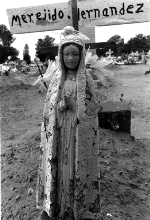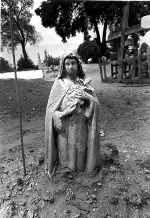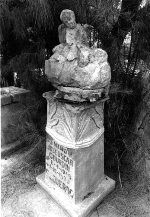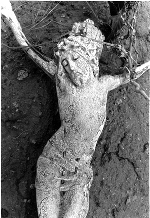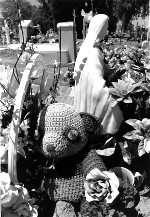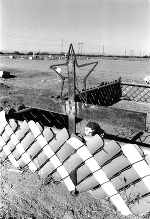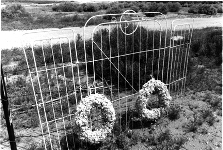Fall 1999, Volume 17.1
Photo/Essay

Shale Sloat
We Who Continue
Shale Sloat graduated from the University of Colorado with a B.A. in Geology. She then spent 15 years in advertising, before returning to Arizona State University as a M.F.A. student. Currently, she lives in Reliance, Wyoming.
[Click on photos to enlarge.]
My first exposure to the cemeteries of Gila River country was through a folk art class at Arizona State University, where I was a graduate student. The place we visited was protected from a subdivision of fairly new houses by a concrete block wall; no landscaping, just white crosses, white paper flowers, and leftover Christmas decorations that shimmered in the heat. Knick knacks and crashed saints stared skyward from the dirt. The visual richness of the scene provided immediate, start the poverty of imagination to which I'd indentured myself in the fine arts department.
Subsequently, I visited every town cemetery that I could locate in southern Arizona in which the tradition of family maintained cemeteries survives. The venture made me happy; for the first time I understood that family members are supposed to feel affection for one another. I was also aware that one day this beauty would be done away with, that the dead would be leveled along with their grave ornaments and their temples, as it were, converted to indistinguishable underground storage units. I tried to record in pictures and words what I could of those graves that were being tended as well as those with no one remaining to care for them. More personally, I needed to immerse myself in the repertoire of gestures meant for the dead. To reconnect myself to an ancient awareness wherein every object is animated by the heart and mind of man and the eternal supersedes the possible. These were the places to do it.
Yuma
Nothing is familiar at Yuma Cemetery save the long cedar needles that lie scattered across the sand and the queer excitement that I feel when coming upon special graves. A year has gone by since I first walked here, and unlike last spring the loose soil is bound by tufts of grass stimulated by the winter's exceptional rains. An old feeling of comfort returns and a type of happiness, both of which arise from an absence of the living. I feel close to these places as if each is filled with friends. Not the people buried here, whom I could never know, but the monuments themselves.
Ajo
A Roman family planted a cedar tree near the house when someone died in order to warn away the Pontifex Maximus, who must avoid the contamination of death. In the town of Ajo's cemetery, cedars nod benignly over graves defined by plastic turf or colored stones but more commonly by concrete thickly coated in white paint. Traditional iron and wood crosses have been supplanted by commercial headstones: prosperity brings formality. It's a lovely cemetery but lacks the mystery of Tubac or potent intimacy of Casa Grande.
Two men pile dirt atop a simple grave, clear away holiday decorations, and prop up fallen saints to the pace of heavy metal music that plays on their truck radio. One wears a T-shirt emblazoned Shit Happens. Both wear baseball caps pulled tightly over their foreheads.
"Let's do half today and quit."
"OK by me," the other assents and they throw their tools into the truck bed.
"Six-pack at Ray's?"
"Let's do it."
Etruscan mourners staged blood combat over burial sites, the "munera" or funeral honors that Romans later prosecuted as gladiatorial games. Blood, and its substitute, wine, and in this area, beer, has been believed by nearly every society to settle the restless hungers of the dead. Comanche women slashed their bodies with shards of glass, with knives or fingernails, and kept the wounds flowing blood for months, to the same end.
Ajo couldn't be prettier, so pretty that it's hard to believe it's a company town built by Phelps-Dodge. I find it easy to picture the arcaded plaza as it must have looked in the 1920s when copper flowed like water and the world was blessedly far away. Lovely palms surround the grassy square today. Old men occupy the post office lobby and snowbirds meet at the grocery. A domed church across from the plaza is white and clean and perfect. I buy frozen yogurt at what was once an elegant soda fountain, then walk the quiet streets.
Tubac I.
This morning as I was exiting the cemetery gate, an L.L. Bean duo warmed by plaid jackets and khaki slacks walked past. On spotting my camera the man declared him self to be a fellow photographer, then quickly conveyed his irritation at a recent event. An Anglo who had retired to Tubac just three years earlier, and who had died recently, was permitted burial in the cemetery by the locals.
As proof, the woman pointed to a dirt mound that was deep in drooping bouquets.
"It must be tough to dig a grave in this boulder field," I said. Indeed, many plots are piled with lava bombs and the oldest section is littered with pocky rocks the size of cantaloupes and honeydews.
"Oh sure," the man said, jabbing his walking stick into the gravel path. "Digging a grave is an excuse for an all night party around here."
"I'm sure it speeds up the work," I ventured, but his mate continued the complaint.
"We went to the town of Sasabe over the border in Mexico and there they buy cut flowers at outrageous expense to put on the graves."
"Yes. The laundry hangs outside and the children have no food," he huffed.
As my thoughts poked around the sin of drying laundry outdoors, a sin I'd never heard of before, I commented, "Wouldn't it be nice to know that you mean that much to your family, even after you're dead?" After all, it was Ovid who declared: None ought to be said to be happy until after death and the last funeral rights.
Their identical expressions said, "Care? They don't care now."
In a strange inversion of roles, as if I were Persephone searching for Demeter, I returned to pursue an ancient act of sympathetic magic. If my mother's spirit is to be found anywhere, it is here among the bloody hands and pierced hearts of the little statues, after-living in perpetual agony with the saints.
Tubac II.
The highway funnels south from Tucson along the Sierrita Mountains and proceeds up the scrubland of the Santa Cruz Valley into Mexico. Tubac was the earliest stop on the route the Spaniards used as they filtered north into Gila River country. Now, for tourists going to Nogales it's a pretty place to eat and shop.
Darkness and wind suit a settlement like Tubac where today the sky is like the lid of a coffin that has been propped open to expose my face to the January wind. I haven't visited the graveyard since July when the air was brutally hot and steamy from rain. The sky was leaden then, too, which made it difficult to take photographs. The maroon, rock-strewn field absorbs all the light the sun can throw at it.
A tomb built in the shape of a small chapel glows whitely against the dark field. I raise the camera to search through the lens, catching my breath at what it reveals. The head of a deer rests on the roof, wedged carefully and secretly into place between the steeple and an air vent, safe from roaming dogs, coyotes and children. Its black eyes fix the sky in mute mediation between the offerer and his kin in the afterworld, its presence at the grave as old as the sacrificial impulse of man.
Christmas carols of an artificial origin drift on the wind to where I examine a statue of Jesus, whose hands have fallen into a birdbath at his feet. Their source is an electronic chip attached to a Christmas card, and when I find it I feel like the sailor in On The Beach who discovers that signals which arise in San Francisco are due to non-sentient activity.
At the foot of the grave is a perfect snakeskin; a pale, translucent strip that blows away as I hold it to the light. "Jingle Bells, Jingle Bells, Jingle all the way…." We speak of the dead as if they have gone on a journey, but it is, after all, we who continue.
Casa Grande
A hard-packed dirt road narrows to pass between two white pillars set barely a car-width apart. I steer the truck quietly between them into a cave of giant salt cedars beneath which sit rows of granite markers at the heads of dry mounds. The soft, dusty soil mixes strangely with the deep gloss of polished rock. I drift farther into the gloom, looking for the shine of white crosses. A large tomb of dark material erected near an irrigation ditch has three Vietnamese names carved into its foot; dozens of graves lie beyond it, each uniquely marked with wood, metal, or concrete crosses, with bunches of flowers or wreaths, with statuary of ducks or bunnies, of Mary, Jesus and El Niño de Atocha, Mickey Mouse and Ss. Jude and Francis, with praying cherubs and Santa Claus.
Two rows of tiny graves catch the evening light in an open area near a caretaker's shed. One is weighed down by a slab, the baby's name traced in wet cement which was later painted an intense, marine blue. Most of the little graves are lavished with gifts of toy trains, cars, dolls and animals, as if the children have merely strayed away like cats or birds and the parents wish to lure them back to safety, but the treats will remain untouched this night and every night.
Coolidge I.
A Chevy Suburban, its engine miss-firing, parks nose-to-nose with my truck. It's been a busy Sunday, with several families having made visits in the hour that I've been here. One couple, each of whom was accompanied by a poodle, debated the location of a relative's grave for several minutes, made comments on the weed problem, then left.
The Suburban family spreads out among homemade markers that are painted green and white and set with crosses of inlaid marbles. One girl darts among them crying, "Where's Mary? Someone come help me."
Her tiny brother volunteers, and the mantle of the Virgin Mary is exposed as they pluck at the leggy groundcover that has sprouted with recent rains.
The cool, green lacework of weeds has been removed from many family plots and the scratches of rake tines show in the dirt. Someone has placed a glass candle holder with a picture of Jesus on it at the head of a grave and next to it an empty Budweiser can. Also a cigarette lighter on which is printed, "It's American to be pissed off."
Coolidge II.
Memorial day has turned windy and Coolidge cemetery is a parched field of silt and sand sporadically stirred and sifted by dust devils. I've parked in the shade of an Oleander hedge and its long branches bounce and hum as gusts of air push through them. Many leaves are brittle and yellow though it's only May. The graveyard makes a harsh impression after six weeks without rain, the desolation enhanced by bunches of artificial flowers that roll across the lanes like tumbleweeds. Three black women and a man who carries a child stand alongside a grave. The women cradle flowers in their arms as if they were babies, their long dresses billowing upward as dust swirls waist-high around them. After securing their gifts to the tombstone, they wander the rows chatting amiably. Only the high music of their laughter is clear to me.
I search for a statue that I meant to photograph on an earlier visit but which was obscured by giant weeds. Suddenly, I'm aware that a young woman is sitting on the grave. Her head rests on her knees and her arms are clasped around her legs. I feel self-conscious, as if I've stumbled onto a doe who hides in a thicket of ribbons and crosses and I veer away. My eyes water from the blowing sand and I cannot see her very well, I hear only that she speaks to whomever lies beneath her.

